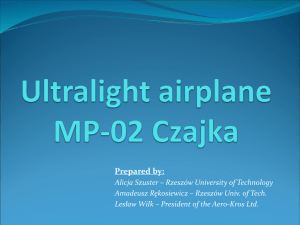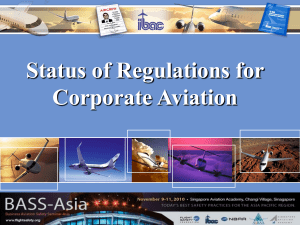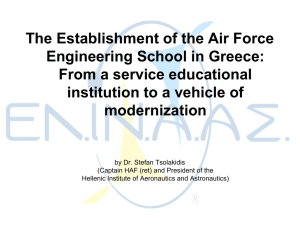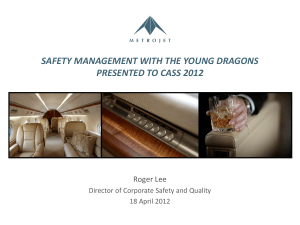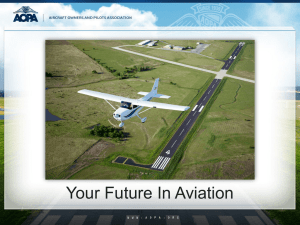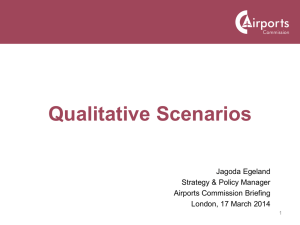Examples of OR Practices at FAA
advertisement
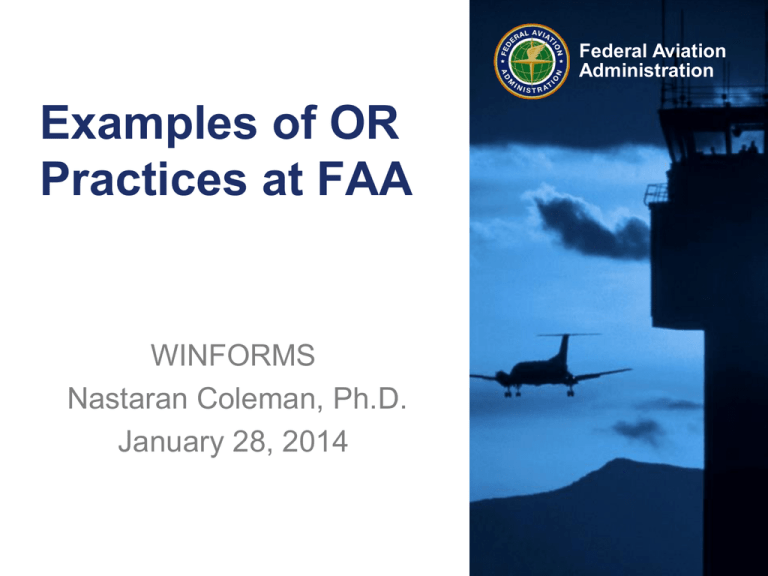
Federal Aviation Administration Examples of OR Practices at FAA WINFORMS Nastaran Coleman, Ph.D. January 28, 2014 Goal and Disclaimer • Goal – To encourage young and future operations research practitioners to consider a career with the Federal Aviation Administration (FAA). • Disclaimer – The opinion expressed in this presentation and following slides are solely those of the presenter and not necessarily those of FAA. FAA does not guarantee the accuracy nor is reliable for the information provided herein. Federal Aviation Administration 2 Mixed Integer Programs Optimize mix of legacy, new navigation services – Very High Frequency Omnidirectional Range (VOR) is ground-based Navigational Aid (Navaid). – Navigation and landing systems evolving from ground-based Navaids to satellite-based navigation (SATNAV) system. – During the transition to SATNAV system, FAA planning to phase out some ground-based Navaids, including some VORs. – Users not equipped with SATNAV avionics will still rely on VORs. – Users equipped with SATNAV avionics may rely on VOR for backup in case of disruption to the satellite-based system. – When is it cost-effective to phase out VORs? • How many? • Which? – What are impacts on flying public? • Non-equipped aircraft rely on legacy Navaids. • How many and which city pairs will be disconnected from VOR network? Federal Aviation Administration 3 Mixed Integer Programs (cont.) Optimize mix of legacy and new navigation services (cont.) – Modeled VOR network as mixed integer program. – Eliminated infeasible variables in very creative way. • Reduced number of variables from several billion to ~5 million. • This is most important, biggest adjustment made to transform problem from being “too complex” to being solvable. – Used relaxation techniques to solve mixed integer program as linear program which almost always produces integer results. Federal Aviation Administration 4 Mixed Integer Programs (cont.) Use optimization model to find most cost-beneficial mixture of NAVAIDs by specific location and see whether Wide Area Augmentation System (WAAS) part of any of these mixtures. • Designed model to include – Efficiency, i.e., avoided disruptions. – Cost savings from ground-based NAVAID decommissioning, not commissioning and maintaining new Instrument Landing Systems (ILSs). – Some complex procedure benefits. – Safety Benefits. • Ran model with various assumptions including equipage levels. Federal Aviation Administration 5 Mixed Integer Programs (cont.) Optimize scheduling of air traffic controller shift start times, shift assignments – Was designed to validate results of contractor scheduler to be used by various facilities. However, this tool can be used to answer questions like • Does facility consolidation increase efficiency? • Do you need additional controllers if you add rest times between shifts or change other constraints • What are effects of adding abilities to control traffic from remote sites? Federal Aviation Administration 6 Mixed Integer Programs (cont.) Estimate look-ahead conflict detection counts related to controllers' workloads • One parameter defining complexity of air traffic controller work is detecting and resolving potential future conflicts. • Objective is to find way to approximate number of potential conflicts in next X minutes in sector, use number to assign complexity level to that sector. • Linear program predicts possible conflicts between two aircraft. • Programming problem • Number of linear programming runs can be enormous (e.g., hundreds of millions for one Center, one day.) • Solution • Many filtering techniques reduce this number of programs to around 1 million linear programs/day for each en route Center. • Many adjustments reduce processing time. • Batch files • Memory leak prevention Federal Aviation Administration 7 Mixed Integer Programs (cont.) • • Model National Airspace System (NAS) with all its airports, fixes, routes as network. Maximize network flow – • Maximum flow problems often used to find maximum amount of flow (aircraft traveled) through network when paths (routes between fixes) have capacity limits. Objective is to design tool to provide Rough Order of Magnitude (ROM) estimates for questions like: – What are potential benefits of reduced separations in en route airspace? • When separation standard remains same in terminal area. • With various airport capacity assumptions. – How much more traffic can NAS handle? • By spreading demand evenly throughout day, not changing airspace, airport capacities. • Use existing capacity at smaller regional airports. – What are NAS’s bottlenecks? – Estimate impacts of weather phenomena like blizzards. Federal Aviation Administration 8 Queueing models Introduced an analytical approach, using ANALYTICA, to estimate future delays by airport for various hourly capacity and demand scenarios. • This model, variants used to estimate future delays to provide ROM estimates for many new technologies, procedures. • Model approximates percent changes in delays due to capacity or demand changes on hourly basis using steady-state, G/G/1 (general arrival and service distributions) queue with First-In FirstOut (FIFO) discipline. • Average airport capacity first estimated using percent arrivals versus departures, and standardized Pareto curves under various ceiling and visibility conditions. Federal Aviation Administration 9 Queueing Models (cont.) Effects of reduced unimpeded taxi-out times on departure delays at capacity-constrained airports • • • • Unimpeded taxi time represents time aircraft travels from gate to runway or vice versa, given no conflicting traffic. Actual taxi times exceed unimpeded times when traffic exists: Aircraft must yield or wait. Will reducing unimpeded taxi-out times through new technology result in taxi-out time savings? These savings not intuitively obvious at capacityconstrained airports where aircraft often wait in departure queues. Using queueing theory, simulation model, have shown that variance of interarrival times into departure queue is only parameter that influences queue waiting time. If equipage less than 100% (mixed equipage) and interarrival time variance same for equipped, unequipped aircraft, then combined variance increases, offsetting some time savings. Federal Aviation Administration 10 Statistical Analyses Trends of scheduled hourly aviation demand distributions at 35 major airports, 1982-2006. • Do shapes of hourly demand distributions change as demand or capacity increases over time? – Build hourly scheduled demand distributions by airport, study shapes of distributions over the year. – Adjust for seasonal variations, day of week by creating hourly distributions using entire year. – Define potential metrics for evaluating changes in hourly schedule demand, capacity over the year. – Create hourly demand distributions by airport and year. Hourly demand pattern changes as demand increases over the years. • How to evaluate hourly demand pattern (peaking versus depeaking)? – Regression results suggests that peak growth is .64% of total demand growth. Federal Aviation Administration 11 Statistical Analysis (cont.) • Using actual data, fit to existing probability distributions or build user-defined distributions for various component of flight. – Do interarrival times to “Fix,” i.e., in-air waypoint, follow Exponentially Modified Gaussian (EMG) distribution? Is Exponential Gaussian Hybrid (EGH) better fit? – How to estimate parameters. • Use moments, but EGH lacks closed-form expression/ • Use graphical measurement to estimate lambda of exponential part, variance of normal part of EGH. • Sample mode is the best estimate of EGH normal mean. Federal Aviation Administration 12 Statistical Analyses (cont.) • Historical accident statistics can be used to – Predict future accident rates for various alternatives. – Evaluate effects of safety program by comparing data before, after program implementation – Identify safety risks so that return on investment is maximized • Historical accident data can help – Derive pool of safety benefits. – Establish the effectiveness of new programs. • Some observations: – Most accidents happen during daylight. No significant difference in rate of fatal accidents in absence of daylight. – Approach, landing, descent most dangerous phases of flight. • Study correlation between various weather conditions and accidents – Turbulence causes most air carrier accidents (mainly non-fatal.) Federal Aviation Administration 13


